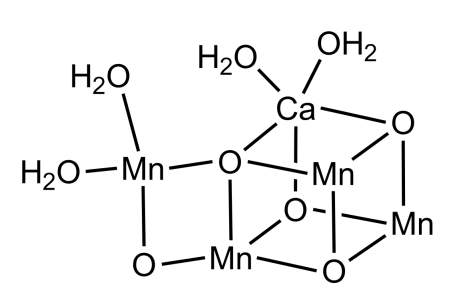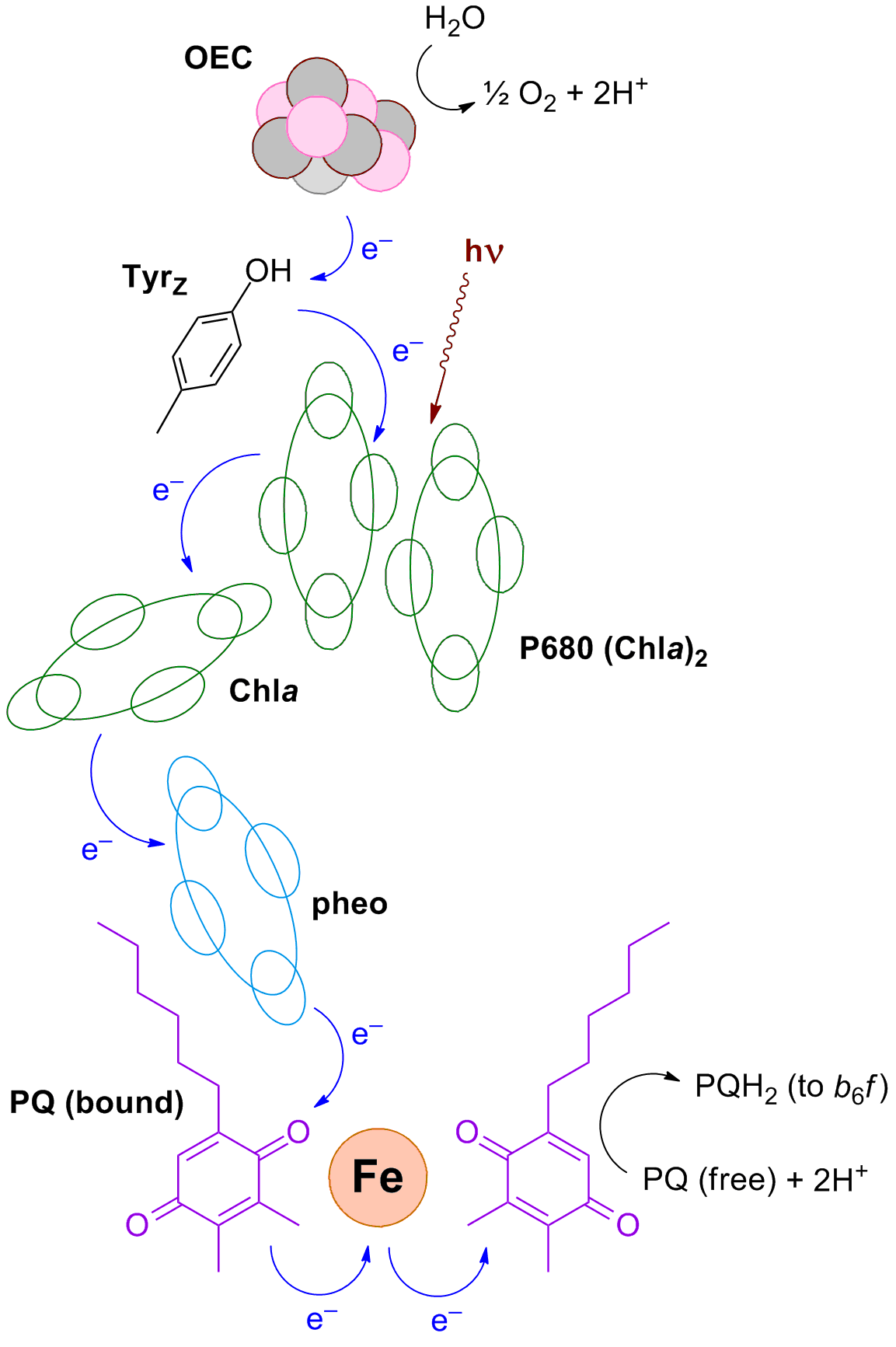

Photosystem II
Structure of Photosystem II from T. vulcanus (cyanobacteria) from Umena, et al. Nature 2011, 473, 55. PDB 3WU2.
To view only the cofactors involved in electron transfer, check the box:
Structure of oxygen evolving cluster:
| The oxygen evolving cluster of Photosystem II is a Mn4CaO5 cluster tethered to the protein by carboxylate and histidine residues. The cluster consists of a roughly cubic arrangemnet of three Mn, the Ca, and four O atoms, with the final O and Mn forming an edge-shared square. This cluster is oxidized through four sequential electron transfers (via a nearby tyrosine) from the fully reduced S0 to the fully oxidized S4 state, in which two cluster-bound [O]2– ions are oxidized to form dioxygen. A favoured mechanism for O-O bond formation involves the coupling in the S4 state of a μ-O briding from the Ca to Mn ion outside the cube to a terminal MnO group (thought to be either formally Mn(V)=O or Mn(IV)-O·), each O being derived from water. The O2 formation releases four electrons into the cluster. |

|
|

|
||

|
P680 is the photocentre of photosystem II, a dimer of closely-spaced chlorophyll a cofactors. The energy of photons harvested by the chromaphores of PSII excites P680, causing a transition from the ground state (Chl a)2 to an excited-state P680*, in which an electron has transferred from one chlorophyll ring to the other: (Chl+Chl–). The excited electron is then passed to another nearby chlrophyll group (light green), initiating and electron transport chain through PSII via a pheophytin (cyan), a protein-bound quinone (purple), a non-heme Fe (orange), and a labile quinone (purple). This electron path is perpindicular to the thylakoid inner membrane, so that upon reduction the quinone uptakes two protons from the stroma. The resulting [P680]+ oxidizes the OEC, above. Four sequential photon exicitations of P680 result in four sequential oxidations of the OEC, leading to the formation of O2 from water and the release of protons to the lumen. |
Cytochrome b6f Complex
Structure of the cytochrome b6f complex from M. laminosus (cyanobacteria) from Kurisu, et al. Science 2003, 302, 1009. PDB 1VF5.
|
Cytochrome b6f (cyanobacterial) |
Cytochrome bc1 (yeast) |
Mobile electron carriers
Structures of:
- cytochrome c6 from S. obliquus (green algae) from Schnackenberg, et al. Science 2003, 302, 1009. PDB 1VF5.
- plastocyanin from P. nigra (poplar) from Guss, et al. Acta Cryst. B 1992, 48, 790. PDB 1PLC.
- ferredoxin from E. arvense (horsetail) from Ikemizu, et al. Acta Cryst. D 1994, 50, 167. PDB 1FRR.
|
Cytochrome c6 |
Plastocyanin |
Ferredoxin |
Photosystem I
Structure photosystem I from S. elongatus (cyanobacteria) from Nield, et al. J. Struct. Biol. 2003, 141, 149. PDB 1JBO.
This page is maintained and copyright by W. Stephen McNeil at UBC Okanagan.
All educational works available on this page are licensed under a Creative Commons Attribution-NonCommercial-ShareAlike 2.5 Canada License. ![]()